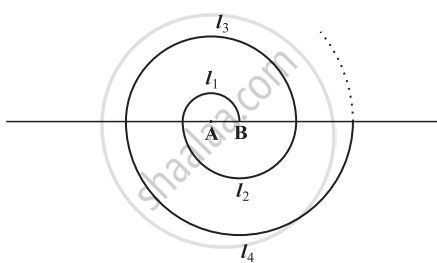Advertisements
Advertisements
Question
A spiral is made up of successive semicircles, with centres alternately at A and B, starting with centre at A of radii 0.5, 1.0 cm, 1.5 cm, 2.0 cm, .... as shown in figure. What is the total length of such a spiral made up of thirteen consecutive semicircles? (Take `pi = 22/7`)

[Hint: Length of successive semicircles is l1, l2, l3, l4, ... with centres at A, B, A, B, ... respectively.]
Solution
Length of a semi-circle
= semi circumference = `1/2 (2pir) = pir`
l1 = πr1 = 0.5 π cm = 1 × 0.5 π cm
l2 = πr2 = 1.0 π cm = 2 × 0.5 π cm
l3 = πr3 = 1.5 π cm = 3 × 0.5 π cm
l4 = πr4 = 2.0 c cm = 4 × 0.5 π cm
l13 = πr13 = 13 × 0.5 π cm = 6.5 π cm
Now, length of the spiral = l1 + l2 + l3 + l4 + ... + l13
= 0.5 π [1 + 2 + 3 + 4 + ... + 13] cm ....(1)
∴ 1, 2, 3, 4, ...., 13 are in AP such that
a = l and l = 13
∴ `S_13 = 13/2 [1 + 13] ....["Using" S_n = n/2 (a + l)]`
= `13/2 xx 14`
= 13 × 7
= 91
∴ From (1), we have:
Total length of the spiral = 0.5 π [91] cm
= `5/10 xx 22/7 xx 91` cm
= 11 × 13 cm
= 143 cm
APPEARS IN
RELATED QUESTIONS
Find the number of natural numbers between 101 and 999 which are divisible by both 2 and 5.
Divide 32 into four parts which are in A.P. such that the product of extremes is to the product of means is 7 : 15.
Which term of the A.P. 121, 117, 113 … is its first negative term?
[Hint: Find n for an < 0]
Find the sum of all natural numbers between 1 and 100, which are divisible by 3.
If numbers n – 2, 4n – 1 and 5n + 2 are in A.P., find the value of n and its next two terms.
Which term of AP 72,68,64,60,… is 0?
Which term of the AP 3,8, 13,18,…. Will be 55 more than its 20th term?
If an denotes the nth term of the AP 2, 7, 12, 17, … find the value of (a30 - a20 ).
Find the first term and common difference for the A.P.
0.6, 0.9, 1.2,1.5,...
The first and the last terms of an A.P. are 8 and 350 respectively. If its common difference is 9, how many terms are there and what is their sum?
There are 25 trees at equal distances of 5 metres in a line with a well, the distance of the well from the nearest tree being 10 metres. A gardener waters all the trees separately starting from the well and he returns to the well after watering each tree to get water for the next. Find the total distance the gardener will cover in order to water all the trees.
Write 5th term from the end of the A.P. 3, 5, 7, 9, ..., 201.
Write the sum of first n odd natural numbers.
Q.12
The sum of the first three terms of an Arithmetic Progression (A.P.) is 42 and the product of the first and third term is 52. Find the first term and the common difference.
Show that a1, a2, a3, … form an A.P. where an is defined as an = 3 + 4n. Also find the sum of first 15 terms.
First four terms of the sequence an = 2n + 3 are ______.
If the numbers n - 2, 4n - 1 and 5n + 2 are in AP, then the value of n is ______.
If the first term of an AP is –5 and the common difference is 2, then the sum of the first 6 terms is ______.
Find the sum of first seven numbers which are multiples of 2 as well as of 9.
